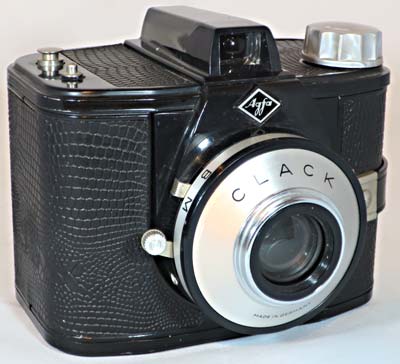Agfa Clack
Specification

| Manufacturer | : | Agfa |
|---|---|---|
| Produced | : | 1954 - 1965 |
| Classification | : | Medium Format |
| Body Type | : | Box |
| Construction | : | Metal |
| Film Type | : | 120 |
| Film width | : | 62mm |
| Image Size | : | 2¼ x 3¼ in |
| No. of Images | : | 8 |
| Lens Type | : | Meniscus |
| Focus Type | : | Fixed |
| Focal Length | : | 85mm |
| Focus Range | : | 10ft to inf. + portrait 3ft - 10ft |
| Aperture Type | : | fixed + yellow filter |
| Aperture | : | f/11 |
| Shutter Type | : | Leaf |
| Shutter Speeds | : | B,I*(1/30 sec) |
| Size (w x h x d) | : | 110 x 90 x 97 mm |
| Weight | : | 320g |
| * Measured on this camera | ||
Art Deco Credentials
![]()
![]()
![]()
Noteworthy: Worth giving special attention
- Produced after the main Art Deco period;
- Body covered in black imitation reptile skin;
- Curvilinear body design
- Agfa logo on front.
Description
The Agfa Clack is a box camera produced by Agfa from 1954 to 1965. It was sold in North America as the Agfa Weekender. About 1.65 million were produced, more than all other Agfa box camera models combined. It is made from sheet metal covered in black imitation reptile leather. The reverse Galilean viewfinder is made from plastic. The plastic carrier strap on left side of body is secured by nickel metal fittings. The winding knob is made of grey plastic. It uses 120 film creating 6X9 negatives. This is big enough to allow contact printing.
The shutter has two modes - timed(B) and instant(M). The timed shutter is like (B)bulb. It has a threaded socket to take a remote cable. It has a single f/11 stop. A lever on the left side allows a yellow filter to be brought into play. The yellow filter works with black & white film to give better contrast between sky and clouds. Alternatively, this lever can also be used to bring in a portrait lens for close-ups.
There are two flash contacts on the top of the camera. The red window has a swinging cover. On the base there is a tripod mount.
How to Use
The manual for this camera can be found here:- Agfa Clack 6x9 manual
This camera takes 120 film which is easily available.
As the shutter speed is only 1/30s, it is advisable to use a tripod to get clear shake free images. However, holding it against a wall or other solid object would work as well. For quick snapshots, hold it firmly against your head.
If you don't want to bother with an exposure meter, follow the guide shown. It is based on the 'Sunny 16' rule. Film is so forgiving and will produce acceptable results even when overexposed by 2 or 3 stops or underexposed by 1 stop.
The tables assume that the sun is at least 30 degrees above the horizon - that's 10am - 5pm on a summers day (May - August) in the UK.
Remember that the exposure guide in the manual may not be helpful as it is based on the use of old film with a low ISO value.
Exposure will probably be reduced by 1 stop when the yellow filter is used.
Using ISO 100/125 film - shutter speed 1/30s
| Weather Conditions | Shadow Detail | Aperture | Exposure |
|---|---|---|---|
 Sunny SunnySnow/Sand | Dark with sharp edges | f/11 | +3 Stops Overexposed Acceptable |
 Sunny Sunny | Distinct | f/11 | +2 Stop Overexposed Acceptable |
 Slight Overcast Slight Overcast | Soft around edges | f/11 | +1 Stop Overexposed Acceptable |
 Overcast Overcast | Barely visible | f/11 | Good |
 Heavy Overcast Heavy Overcast | None | f/11 | -1 Stop Underexposed Acceptable |
 Open Shade Open Shade/Sunset | None | f/11 | -2 Stops Underexposed Not Acceptable |